Molly Twirls-a-lot – Princess Tutu
Children, young and old, gather around if you enjoy a good fairy tale. Let me regale a tale of unspoken love and dark curses; brave knights and gallant princes. Of course, what is a story without two princesses and a dead man who isn’t quite dead enough?
It’s Pronounced Baah-Lay, Not Baah-Let
Sparkles? Tutu’s? What could this all mean?! Don’t let the title fool you, because there is something dark and brooding beneath it’s sparkly exterior. I speak only of the under appreciated Princess Tutu.
What started in Ikuko Itoh’s mind as a vague image of anime set to classical music turned into a full-blown balletic theme. As the basic driver to the overall story, ballet makes up the majority of the physical and spoken interactions between characters to replace the resolution of conflict using violence with implied movement and dancing. What should be a run-of-the-mill fight scene, we, instead, get a highly choreographed queue of Jetés(1) and Fouettes (2) with a sword thrown in for good measure.
The first impressions of this series are out right amusing. What is generally assumed with a title as childish as Princess Tutu is, “A good ballerina and, like, a bad ballerina duke it out, right?” As far as bare bones go, that pretty much sums it up, but fortunately, this anime delves quite a bit deeper into the theme of free will and predetermined fate.
Bring in The Stock Footage (I’m Not Dead, I Just Control Your Life)
Princess Tutu follows a silly little duck, named Ahiru, the Japanese word for Duck, (this will be explained later) who wishes to dance with the lovely and mysterious prince, Mytho (Muto). Granted the chance to become human by a strange, god-like character, Drosselmeyer, Ahiru takes up residence in Kinkan Town and finds herself in the probationary class of the ballet school of Kinkan Academy.
With her loud-mouthed, romantic cliché-loving friends, Pike (pronounced PEE-KAY eluding to the ballet term “Pique” (3)) and Lili, her marriage obsessed ballet master, Mr. Cat, who is, in fact, a dancing cat, and the mysterious advice giving puppet, Adelle, Duck stumbles along as a human girl with normal human girl problems of love and dedication. Duck, though, has to keep one minor secret… or two actually…. Scratch that, three.
She is a duck who is a human who is a storybook heroine named Princess Tutu who turns back into a duck if she quacks and back into a girl when she comes into contact with water, but we get a little Fruits Baskety because she always returns to her human form buck naked. So are we talking about a comdedy anime, a magical girl anime, a drama? A sense a little bit of an identity crisis.
Despite his death, the entire cast’s existence is all under the control of the famed storyteller, Drosselmeyer. The story acts as an afterword to his unfinished story, “The Prince and The Raven” who’s characters left the story to protect one an other and the “world” as they know it. I won’t go too much into the details, but each character in the normal world of Kenkan town is a pivotal character from this book attempting to veer away from their written fates:
Mytho, the prince who lost his heart to seal away the evil raven; Fakir (Fakia), the brave knight who died by the claws of the raven to protect the prince; Rue (Princess Kreahe), the raven’s daughter who is sent to keep Mytho from getting his heart restored; Princess Tutu (Ahiru), a beautiful ballerina who works to restore the lost shard of Mytho’s heart and is unable to speak of her love for the prince for she is fated to disappear in a flash of light if she does so.
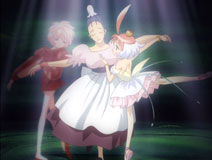
Each episode or each occurrence in which a heart shard must be returned revolves around a different ballet, some being more obvious like The Nutcracker or A Midsummer Night’s Dream and others less known to those who aren’t versed in classical ballet like Ruslan & Ludmilla (my absolute least favorite ballet), Giselle (my favorite ballet) or Coppelia.
A very clear protocol comes into play with each episode:
~The being whose heart is being controlled by the emotion of that heart shard is identified.
~Duck turns into Princess Tutu.
~Tutu asks the person to dance with her.
~The shard is returned to Mytho.
~Mytho then turns all melodramatic and falls more in love with Tutu.
Luckily for us, this cycle breaks near the end of the series, letting us get deep into the real “deal” with this screwed up fairy tale. I really don’t want to go any farther into the plot because, holy plot twists, Batman, it gets intense.
Just Pick a $@%^ Name and Be Done With It!
I feel as though I should explain the whole name fiasco. There seems to be a disconnect between how the name is written, how it’s pronounced in Japanese and how we English speakers say it. The odd names are as follows:
~Written: Fakir. Pronounced: Fakia.
~Written: Mytho. Pronounced: Muto.
~Written: Pike. Pronounced: Peek.
Ahiru is a special case. In the Japanese version, her name is actually “Ahiru” which is meant to be a joke, because she is very much so a duck. Of course, the silly Americans that dubbed the series took this name as well as the other names much too literally. They named her Duck…. WHY?! Way to be, ADV. In fact, that is my biggest gripe with the dub. They say the names so literally that it sounds annoying to the ear. If you can avoid the dub, please do. I much prefer the Japanese pronunciations and the voices. They created a whole, working package. However, this brings me to another bizarre point.
Princess Tutu takes place in some pseudo-Germanic town, dubbed by Japanese people with a very French vocabulary. Talk about culture confusion. Though they seem to blend all this well enough that once you get past to the talking animals acting as students (Egad, talking Mere Cats?!?!), you really can’t tell.
A Spotlight for You, One For You, You and You, Too
One aspect of this series that plays to it’s advantage of having many many characters introduced at some point or an other is that everyone seems to get their twenty-four minute spotlight. The first season focuses more on Ahiru’s development as a princess duck thing and getting the audience used to the episodic set up of each short story. We don’t stray much, which means the supporting characters strictly remain supporting characters.
As we venture into the second season we FINALLY learn about the characters Rue and Fakir and his freakish connection to our God-man, Drosselmeyer. We also learn that Drosselmeyer has something for sadism as he has a soft spot for painfully dramatic stories. I will say, though, that the story is more entertaining at its darkest points.
All About The Details (Enter Witty Comment Here)
This series is full of inside jokes, hints and nudges and the like keeping the watchers on their toes. To any dancer, they would notice right off the bat that Mr. Cat is always doing his queue of Pas De Chats when riled up like a cat in heat (did I really just use that joke?)(4), which is aptly named the step of the cat. Not a funny joke, but a cute detail. In other instances we find our illustrious Mytho dancing solos to well known classical music, though most fail to notice that he’s performing to woman’s variation music on a couple of occasions, most notably being the Sugar Plum Fairy variation from The Nutcracker. He still makes it plenty masculine for the purpose of flaunting strength, dexterity and all of his sexy mysteriousness.
Other small details include the many Swan Lake motifs such as the Swan crests on the dorms, statues around the campus and the large cuckoo clock. The most obvious Swan Lake reference would be the white swan/ black swan opposing characters (Princess Tutu and Princess Kreahe). They play with the roles of Odette and Odile from the ballet, Odette being the white swan that captures the heart of the prince and Odile who acts as Odette to steal the prince away. For a ballerinerd like myself, that really made me smile.
Obligatory Basic Review is Obligatory
Usually, by this point in the review I would comment on the visual and musical aesthetic of the anime. I’ll keep this short and to the point: stunning animation, fluid movement which works to it’s advantage making the ballet very smooth for it being animated and the soundtrack, though borrowed from pre orchestrated ballets, operas (Carmen being the most notable) and other popular pieces of classical music, was clean and well placed. OK, that’s enough of that.
Fangirls Abound

Princess Tutu offers something for every taste: drama, romance, dark/fantasy themes, comedy and, of course, the arts, ballet playing the prominent role. Though the cast is very much so designed to fit the typical set fairy tale characters, including your obligatory fangirls, they are amusing and endearing enough to keep you interested. As far as annoying characters go, though, Pike and Lili don’t have much of a purpose except to be annoyingly simple. They have their shticks, and that’s about it.
“Once Upon a Time, There Was a Man Who Died” (And Then There Was an End)
As each story comes to an end, each review does, too. What can I say to satisfyingly close out this balletic babble?
You don’t have a be a bun-head to find joy from this anime, though knowing your way around French terminology couldn’t hurt. Luckily for you, if you happen to pick up the DVD’s, the extras spend some time to familiarize you with the ballets referenced in each episode and the movements and mimes primarily used throughout the anime. Think of it as a crash course in ballet, albeit an amusingly simple one. Let’s just say you’ll be the authority on the art of the Pas de Deux (5) by the end of this series, whether you like it or not.
The storybook structure of this tale creates a nostalgic atmosphere that brings you back to a time of outlandish children’s stories and happily ever after’s. You will (hopefully) be left feeling heart-warmed and a tad bit more cultured after 26 episodes of classical music.
And They Finished This Review Happily Ever After
I hope this left you vying for some pirouetting (6), sword wielding action. Princess Tutu has everything to satiate your needs from an anime. Never has the storybook theme been executed so smoothly. Though they seem to attempt to cram as many themes and concepts as possible into this short series, I don’t find it too overwhelming. I say, watch it once then pick it up again from the beginning six months to a year later and see how your understanding has increased. You’ll catch all the nuances and details you may have missed the first time since you will be armed with a previously acquired knowledge of all things balletic and theatrical.
———————————————————————————————–
OK OK! Now, It’s Over!
How about I leave you to ponder over this ridiculous question to keep you busy until next month:
If you were a pretty pretty, tippy-toe dancing princess, what would your sparkly name be and how would you use your sparkle powers? For good? For evil? For pizza? The best answer gets a cookie (not really).
Ballet Glossary:
(1) Jeté– Throw (In French)- In most instances, a large jump in which both legs are separated in the air to create an elongated line with the legs. A simplified version can also be done from a standing position.
(2) Fouette– Whip– A difficult turn done most times en pointe (on hard shoes to stand on your toes) in which the free leg is whipped around from front to side to turn between 8 and 32 times around the axis of your standing leg.
(3) Pique– Prick– A quick movement either done standing where the free foot quickly touches the floor or a simple traveling turn where the free leg bent at the knee and the foot touching at or just below the knee while turning around the axis of the supporting leg.
(4) Pas de Chat– Step of the Cat– A simple jump in which both legs are bent in the air and the toes are nearly meeting. It can also be done in which the first leg to take off of the ground extends in the air leaving the other leg bent (Grand Pas de Chat)
(5) Pas de Deux– Step of two or Dance for two– A dance with two people including an Etreé, an Adage, two solos and a Coda.
(6) Pirouette– Turning– A simple turn in which the non supporting leg is bent at the knee and the toe is brought to or just above the knee of the supporting leg.
Questions? Comments? Critques? Adoration? Leave your words here or in the newly reorganized Molly Rants-a-lot section of the forums.




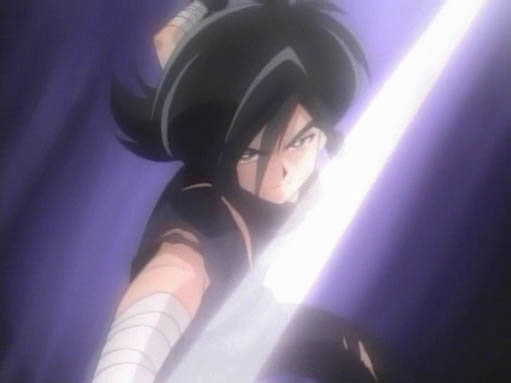

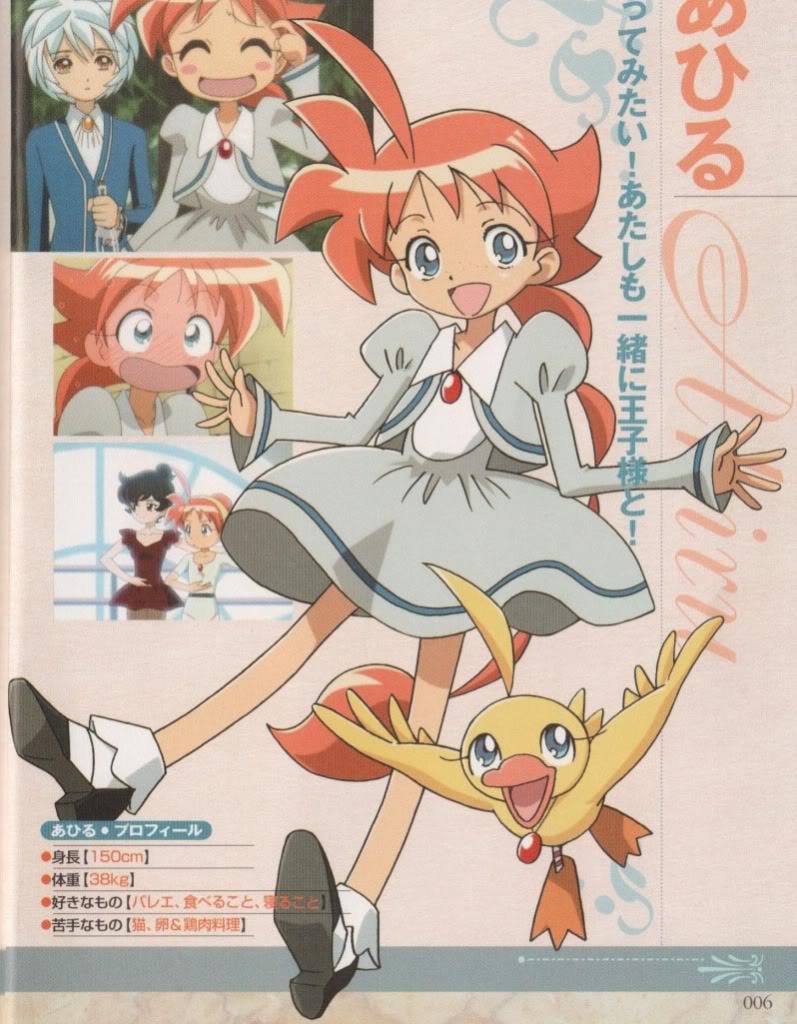

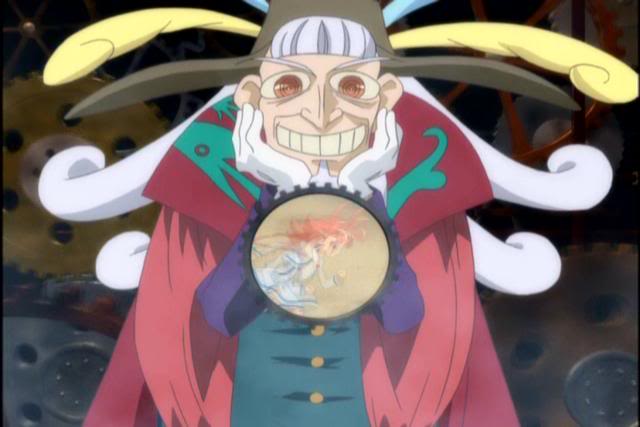



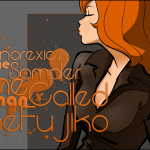










Molly, you have made me a very happy fangirl. I am actually a closet fangirl of PTutu, and it is, admittedly, one of my favorite shows ever. I hate to admit it, though, because it’s so artsy and Tutu technically talks down the badguys every episode with her magical princess powers (?!). But the show is mind-bogglingly good, and you managed to tell me some things I didn’t even know (Mytho dances a girl-dance? Oh, this is SO going onto my yaoi list for him…).
I’d be Princess friggin’ Tempest and I’d use my powers to steal the world’s chocolate in order to create a ballet outfit entirely out of Hershey’s wrappers. I’d be the fattest ballerina since Fantasia and the world will weep — WEEP, I say — when I get up on my tippy toes.
I tried to watch the first episode of this series, but I couldn’t really focus on it enough, of course, this was back in my beginning days of anime, where action was my genre of choice. I might give it another try, since Kannie really wanted me to watch it.
Anyone got some DVDs I can borrow, or is it up on TAN or CR?
Also, I wouldn’t be a ballerina, I would be the person that doesn’t dance ballet, but rather performs some cross between breakdancing and brazillian jiu jitsu. Or something manlier. 😛
I dunno about being a princess Jubilee…but I have Sparkles! awesomeface
Happy Lupe is happy. Not a lot of people talk about the awesome that is Princess Tutu (At least, that I’ve seen). It’s nice to see good yet lesser known anime get the attention they deserve now and then.
I’m glad you (and a handful of others) appreciate this series as much as I do! Tutu deserves more attention and a better dub, but I can settle with a few people with niche interests in terms of anime. Thanks for reading!!
Molly, great review but you got the name of the show wrong! It’s called Guitar Ninjas! That’s the only name epic enough to fit the show!
I’m not sure I follow, friend. But thank you!
[…] turn for the dramatic during the second half of the series. Since MollyBibbles has already done an article covering Princess Tutu and in more detail than I’d have room for […]